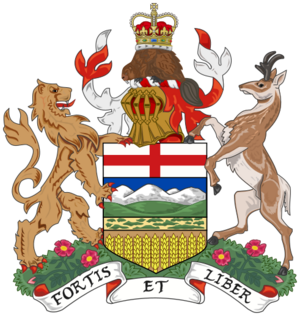Executive Council of Alberta facts for kids

|
|
| Nickname | Cabinet of Alberta |
|---|---|
| Formation | January 9, 1905 |
|
Membership
|
|
| Charles III | |
|
Represented by
|
Salma Lakhani, Lieutenant Governor |
|
Chair
|
Danielle Smith, Premier |
|
Staff
|
Government of Alberta |
The Executive Council of Alberta is also known as the Cabinet. It is a group of important people called ministers who help run the province of Alberta. These ministers work with the Lieutenant Governor to make decisions for the Government of Alberta. The Premier chooses these ministers. Most of them are also members of the Legislative Assembly (MLAs). The Executive Council of Alberta is like the main team that leads the provincial government.
Contents
Special Titles for Members
Members of the Executive Council are given a special title: "the Honourable." This title shows respect for their important role. Once someone has been a member, they usually keep this title for life. This is a way to recognize their service to Alberta.
What the Cabinet Does
The Executive Council of Alberta plays a very important role in how the province is run. The official power in Alberta belongs to the Lieutenant Governor. However, the Lieutenant Governor usually acts on the advice of the Premier and the Executive Council. This means the Cabinet makes the real decisions.
The Lieutenant Governor has three main types of duties:
- Constitutional duties: These are official tasks, like giving royal approval to new laws.
- Ceremonial duties: These include attending special events and representing the King.
- Social duties: These involve meeting people and supporting community events.
The current Premier of Alberta is Danielle Smith. She became the 19th Premier on October 11, 2022. She leads the Cabinet and guides the province's direction.
Who is in the Cabinet?
The Executive Council of Alberta is similar to the Cabinet of Canada, which runs the federal government. However, Alberta's Cabinet focuses on provincial matters. These include things like education, health, and roads within Alberta. The federal Cabinet deals with national issues.
The Lieutenant Governor is the official head of the Council. They are sometimes called the "Governor-in-Council." The Premier chooses the other members of the Cabinet. The Lieutenant Governor then officially appoints them. Most Cabinet ministers are in charge of a specific government department, called a ministry. For example, there's a Minister of Health and a Minister of Education. These ministers are responsible for their department's work and report to the Legislative Assembly.
Current Cabinet Members
The current Cabinet has been working together since June 9, 2023. Here are some of the key members and their roles:
| Portfolio | Minister | Took office |
|---|---|---|
| Premier of Alberta and Minister of Intergovernmental Relations | Danielle Smith | October 11, 2022 |
| Deputy Premier of Alberta and Minister of Public Safety and Emergency Services | Mike Ellis | June 9, 2023 |
| Minister of Infrastructure | Peter Guthrie | June 9, 2023 |
| Minister of Finance and President of Treasury Board | Nate Horner | June 9, 2023 |
| Minister of Jobs, Economy and Trade | Matt Jones | June 9, 2023 |
| Minister of Justice | Mickey Amery | June 9, 2023 |
| Minister of Health | Adriana LaGrange | June 9, 2023 |
| Minister of Energy and Minerals | Brian Jean | June 9, 2023 |
| Minister of Tourism and Sport | Joseph Schow | June 9, 2023 |
| Minister of Environment and Protected Areas | Rebecca Schulz | June 9, 2023 |
| Minister of Technology and Innovation | Nate Glubish | October 21, 2022 |
| Minister of Affordability and Utilities | Nathan Neudorf | June 9, 2023 |
| Minister of Municipal Affairs | Ric McIver | June 9, 2023 |
| Minister of Transportation and Economic Corridors | Devin Dreeshen | October 21, 2022 |
| Minister of Agriculture and Irrigation | RJ Sigurdson | June 9, 2023 |
| Minister of Forestry and Parks | Todd Loewen | June 9, 2023 |
| Minister of Immigration and Multiculturalism | Muhammad Yaseen | June 9, 2023 |
| Minister of Education | Demetrios Nicolaides | June 9, 2023 |
| Minister of Advanced Education | Rajan Sawhney | June 9, 2023 |
| Minister of Service Alberta and Red Tape Reduction | Dale Nally | October 21, 2022 |
| Minister of Indigenous Relations | Rick Wilson | April 30, 2019 |
| Minister of Seniors, Community and Social Services | Jason Nixon | June 9, 2023 |
| Minister of Children and Family Services | Searle Turton | June 9, 2023 |
| Minister of Mental Health and Addiction | Dan Williams | June 9, 2023 |
| Minister of Arts, Culture, and the Status of Women | Tanya Fir | June 9, 2023 |
Past Cabinets of Alberta
Many different Cabinets have led Alberta throughout its history. Each Cabinet is named after the Premier who was in charge at that time. Here are some of the Cabinets from recent years:
- Klein Ministry (1992–2006)
- Stelmach Ministry (2006–2011)
- Redford Ministry (2011–2014)
- Hancock Ministry (2014)
- Prentice Ministry (2014–2015)
- Notley Ministry (2015–2019)
- Kenney Ministry (2019–2022)

